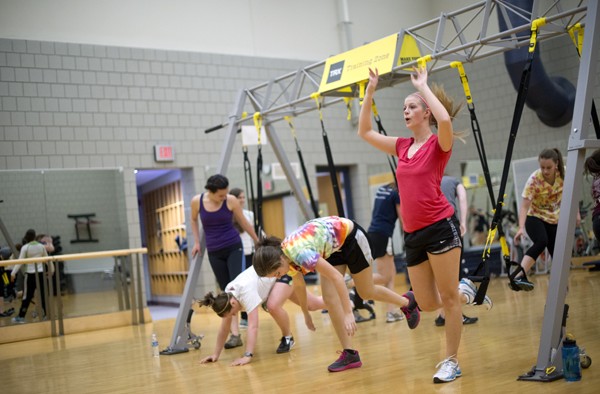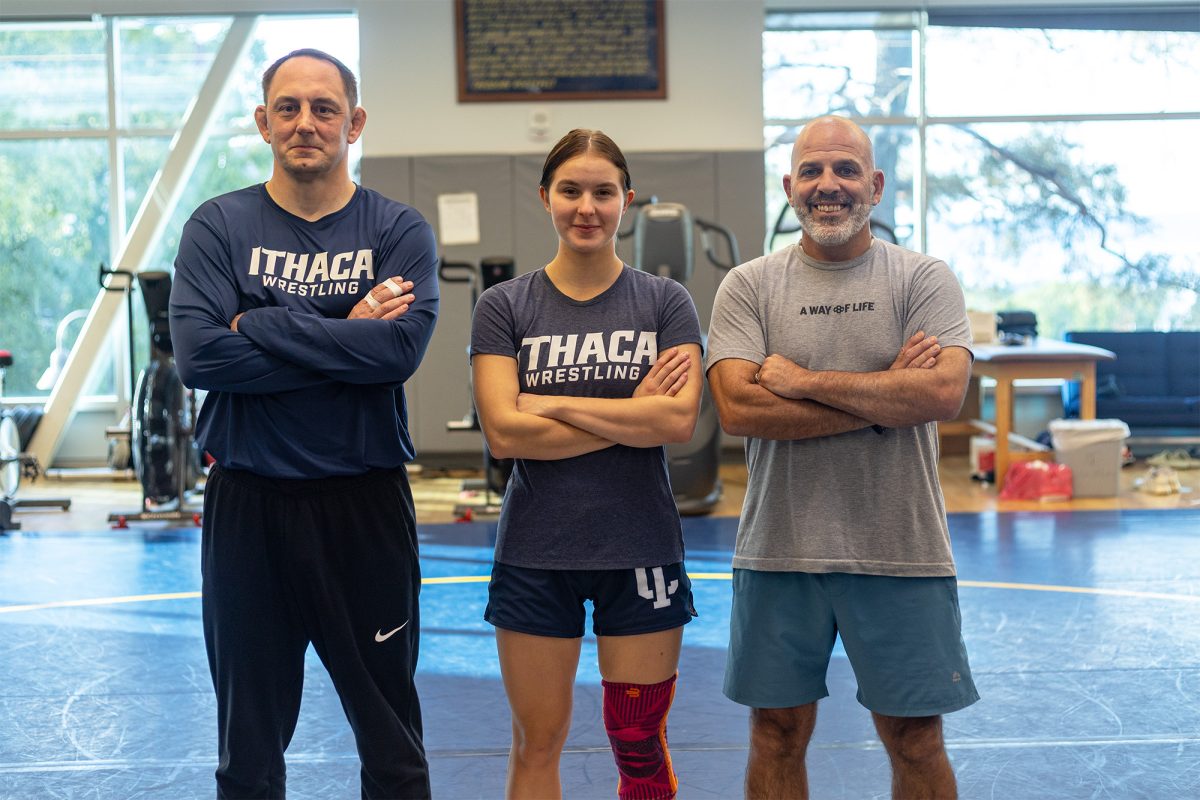Before the sun rises on South Hill, a group of 12 groggy students gather in the Fitness Center’s aerobics room, ready to take on the metal scaffolds and taut straps of the new TRX device.
Graduate student instructor Aline Pugliesi invites the group in and has them begin a short set of warm-up squats and mimic a rowing action on the straps to stretch out and prep the muscles for exercise. The more experienced members seem unfazed, while some begin to sweat and try to catch their breath.
“You guys aren’t done yet, are you?” Pugliesi says lightheartedly.
The class smiles and shakes their heads, and the real fun begins.
The group simulates push-up motions on the bands for about 30 seconds only to drop down to the ground for actual push-ups. Before they can catch their breath, Pugliesi has the students stand up to do biceps curls and finish off with tricep curls. During this time, the heart rate may be lowered but muscle groups are constantly being targeted, and every one from the shoulders down to the hamstrings gets a deep stretch and an even deeper burn.
TRX, a 45-minute suspension training workout, is the newest exercise program to find its way to South Hill. TRX is a device composed of a set of bands around the top of a large grey and yellow metal suspension bar. Employing different levels of resistance, users work against their own weight to engage their core. As of this fall, TRX is available to students at the college.
Sean Reilley, program coordinator of recreational sports, said the Fitness Center staff makes an effort to bring new programming to the campus each semester. He and assistant director Brad Buchanan collaborated during the past summer and decided to bring TRX to the South Hill because of its growing popularity in gyms across the nation.
“We try to do our best to match our programming to what we offer here to stay current in the industry and what’s being offered in mainstream gyms,” Reilley said.
The entire bar allows up to 12 participants to exercise at the same time, if the instructor is not included. The TRX workout’s small class sizes allow for participants of all levels of fitness and skill to receive individual attention and training while still enjoying the benefits and camaraderie of a larger group workout.
“It’s something that can be applied very uniquely from a one-on-one personal training session to a group setting,” Reilley said.
Pugliesi said she got her first experience with a training program in 2010 and said it is a program that emphasizes core strength and stability, and that wide ranges of people can do it.
“No matter what you do, whether it’s working on your back or legs, there’s part of your core being worked,” Pugliesi said. “It’s body-weight resistance, so you can train each strength and resistance level.”
Reilley said that 149 different students have taken a TRX class this semester, and it is likely that the program will continue next semester. While TRX is gaining popularity both at the college and nationwide, Charles Lantz, one of the level two instructors at TRX headquarters in San Francisco, said the workout can be very beneficial, but it might not be for everyone.
“You shouldn’t come back and workout if you’re seriously injured through their back and through their core and through their shoulders because you’re really risking your chances of recovery,” Lantz said. “You really have to listen to your body and make sure you’re taking common sense into account [before doing the workout].”
Graduate student Sara Kidder has been a weekly participant at the TRX classes offered by the Fitness Center since the class began in the fall. She said she got her first experience with TRX during a summer clinical session in Rochester, N.Y., and the nature of the workout was beneficial to her, even after injury.
“I like the fact that it’s a whole-body workout, as it’s something where you can switch from legs and arms without using different workout tools,” Kidder said. “I’ve had a couple injuries, and it’s very low impact, so it doesn’t hurt [my] joints as much as other workout techniques.”
Reilley said the TRX training shifts from using traditional equipment, such as dumbbells and free weights that train and build the muscle, toward a functional training system that trains the movement and creates strength in motion. Reilley said the exercise industry is trending toward functional systems like TRX, and its incorporation helps students with exercise science majors and other therapy-based majors get real exposure to something that is being used in the industry.
“We have some talented students on staff right now, and we’re trying to grow the number of students that we have through exercise science, physical therapy and occupational therapy majors and bring them here so they can have a little more experiences more related to when they leave,” Reilley said.
Even though the fall semester is winding down, new students are still joining the class every week to face the challenge TRX brings. Freshman Jeannine Confer did her first TRX workout Wednesday and said the workout provided an enticing challenge that will bring her back in the weeks remaining in the semester.
“You feel sore afterwards, but it literally worked my entire body, so it was a lot of fun,” Confer said.









